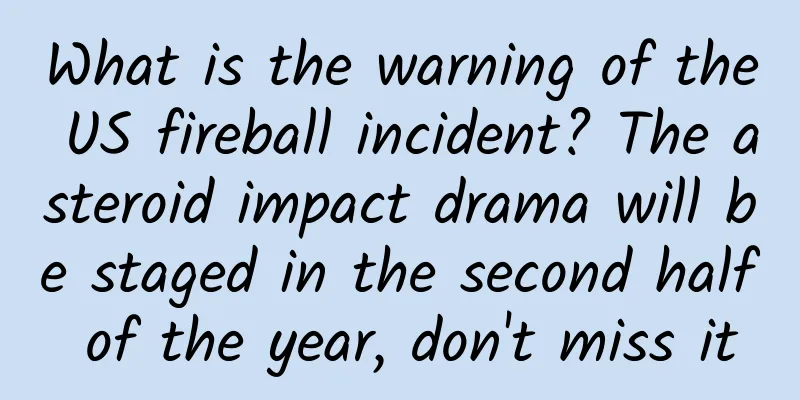What is the warning of the US fireball incident? The asteroid impact drama will be staged in the second half of the year, don't miss it

|
Around 8 a.m. local time on April 27, many people in Mississippi, Louisiana, and Arkansas in the southern United States heard a loud noise from the sky and saw a huge fireball flying across the sky. This was not an isolated incident. Less than a month ago, many people in Indiana, the United States, heard a huge roar at night, and many witnesses saw a giant fireball flying across the sky. Were the Americans testing some new weapons, or were they being visited by alien flying saucers? No. NASA (the abbreviation of the National Aeronautics and Space Administration) soon announced that these fireballs were not man-made objects, nor were they alien objects, but rather fireballs. What is a fireball? A fireball generally refers to very small space debris that hits the Earth's atmosphere due to orbit or the Earth's gravity. Due to its extremely high speed, it produces high-temperature combustion when it rubs against the Earth's atmosphere, so people see a fireball. Those fleeting meteors are smaller fragments that burn up the moment they hit the atmosphere and cannot form a large fireball. According to NASA estimates, the small meteorite that hit on April 27 was about 30 centimeters in diameter, weighed about 40 kilograms, and traveled at a speed of 88,500 kilometers per hour, or 24.6 kilometers per second. Therefore, its energy was also very large, and the power of the explosion reached 2.9 tons of TNT high explosive equivalent. In fact, the phenomenon of fireballs is far more than what people see. Scientists estimate that at least 50 million fragments of fireballs pass through the space near the earth every day, and about 30 enter the earth's atmosphere every year. Some of these fireballs are seen by people, while others are not seen by humans in remote areas. Recently, NASA was authorized to publicly release decades of "fireball" events collected by US sensors. According to the data released by NASA's Center for Near Earth Studies (CNEOS) Fireball Database, thousands of "fireball" events have been recorded around the world since April 15, 1988. (See the picture above) Although these fireball events did not cause significant losses to humans, they seem to be a constant warning to people: the countless asteroids in the sky pose a constant threat to the Earth. If a slightly larger one hits the Earth, humans will suffer a huge disaster. How many asteroids are there that threaten the Earth? In addition to the Sun, the only star in the solar system, the larger celestial bodies are the eight planets and several dwarf planets, as well as hundreds of satellites of the large planets. The rest are considered asteroids. The asteroids in the solar system are mainly concentrated in the asteroid belt, the Kuiper belt, and the Oort cloud belt, and their number is incalculable. Scientists estimate that there are trillions of comet nuclei in the Oort Cloud alone. However, it is too far away and rarely comes near the Earth. Currently, 98.5% of the asteroids observed by humans come from the asteroid belt that is closer to us. The asteroid belt is between the orbits of Mars and Jupiter, occupying an orbital range of 2.17~3.64AU (astronomical units, 1AU is about 150 million kilometers) from the sun. According to the International Astronomical Center, as of 2020, there are about 1.03 million confirmed asteroids in the solar system, of which 57% have been officially numbered. These asteroids are not the kind of debris that cause fireball events. The smallest is generally more than 3 meters, and the largest has a diameter of several hundred kilometers. There are now hundreds of known asteroids with diameters greater than 4 kilometers, and more than 2,000 asteroids with diameters greater than 1 kilometer. The biggest threat to Earth are near-Earth asteroids, which are asteroids whose orbits intersect with Earth's orbit. As of December 31, 2020, the number of near-Earth asteroids monitored was 24,810, of which 2,200 were potential threats to Earth. More than 500 of these near-Earth asteroids have a diameter of more than 1 km. If any one of them hits the Earth, it will cause a devastating disaster. Therefore, asteroid impacts are one of the biggest threats to human survival and continuation to date. To avoid asteroid impacts, two key things must be done: first, accurate monitoring, early detection and early positioning; second, destroying the asteroid or shifting its orbit. Several cases of asteroids attacking the Earth If a slightly larger asteroid hits the Earth, it will cause disasters to the Earth's creatures and even lead to mass extinction of species. 65 million years ago, an asteroid with a diameter of about 10 kilometers hit the Earth, causing the extinction of 85% of species, represented by the dinosaurs. The Tunguska explosion occurred in Siberia, Russia on the morning of June 30, 1908. It was just a comet with a diameter of about 30 meters that hit the atmosphere. It exploded and evaporated before hitting the surface, but it caused the destruction of more than 2,200 square kilometers of forest, and the bright light of the explosion illuminated Europe. In 2013, an asteroid with a diameter of about 15 meters and a weight of about 7,000 tons passed over the sky of Chelyabinsk, Russia. The dazzling light it emitted once exceeded the sun. Many people witnessed this event, and it also caused temporary blindness in many people's eyes. It exploded violently at an altitude of 30 kilometers, with a power equivalent to 480,000 tons of TNT. The explosion fragments became meteorites and scattered on the ground and ice lakes. Some of them smashed houses. The explosion shock wave affected thousands of square kilometers, causing damage to more than 7,000 buildings, shattering glass windows, and seriously injuring more than 1,500 people. This is the largest asteroid attack on humanity since the Tunguska explosion. It can be seen that any asteroid larger than 10 meters can cause disasters to humanity. Humans have also experienced several asteroids passing close to Earth. Although they were only false alarms, they also gave humans more warnings. For example, on July 25, 2019, an asteroid named 2019 OK passed by Earth at a distance of 72,000 kilometers, which is less than six times the diameter of the Earth! 2019 OK is 57*130 meters in size and has a speed of 88,500 kilometers per hour. The energy of its impact on the Earth can reach more than 5 million tons of TNT equivalent, which is 387 times the power of the Hiroshima atomic bomb! What is even more frightening is that this asteroid has not been monitored until 1 hour before it passed by the Earth. If it really hits the Earth, people will have no way to prevent it or hide from it. Asteroid prevention has become a global issue. In order to deal with the threat of asteroids hitting the earth, the scientific community took action as early as the last century. The first to take action were professors at the Massachusetts Institute of Technology in the United States. In 1967, they first proposed the topic of asteroid defense in class, studying how to deal with it if they knew that an asteroid was going to hit the earth. Since then, many visionary scientists around the world have been working hard to explore ways to avoid asteroid impacts, proposing kinetic impacts, gravitational drag, nuclear bomb explosions and other methods to avoid threats to the Earth, but no reliable method has been found so far. The consensus reached by everyone is that the earlier an asteroid that may hit the Earth is discovered, the better. Therefore, early warning and monitoring are very important. The United Nations established a corresponding organization in 2008, which was originally called the Federation of Space Explorers. After the Russian asteroid incident in 2013, the international community further realized the urgency of preventing asteroid hazards, and thus formally established the "International Asteroid Warning Team". Although it is just a "group", the power it can mobilize is huge. This organization is composed of scientists, observatories and space agencies from all over the world, and they share information on new discoveries. Once an asteroid is found that may threaten the Earth, member states will be notified, and the United Nations Committee on the Peaceful Uses of Outer Space will initiate a mission to deflect the asteroid from its orbit. The drama of hitting an asteroid and causing it to deviate from its orbit is about to begin. Scientists have conducted many experiments on hitting asteroids. For example, in 2005, NASA launched a Deep Impact probe to carry out a deep impact on the comet Temple 1 near the earth. The diameter of the impact crater reached 200 meters and the depth reached 30 to 50 meters. Since 2017, NASA has launched the DART Double Asteroid Redirect Mission, which is a real-life rehearsal for future asteroid threats. The main content of the mission is to launch a spacecraft to hit one of a double asteroid that is close to the Earth and orbiting each other at high speed, so as to change its trajectory. This is not a hypothesis, but a real collision. After several years of design and construction, the DART spacecraft was launched in November 2021. Its target is a binary asteroid system called "Didymos". Its primary star Didymos is about 780 meters in size and rotates once every 2.26 hours; the secondary star Dimorphos is about 160 meters in diameter and orbits the primary star every 11.9 hours. The distance between the two stars is more than 1 kilometer. Although the orbit of this binary star system is close to the Earth, it will not collide with the Earth, so this test is just an exercise. The DART spacecraft measures 1.8*1.9*2.6 meters, with a mass of about 610 kilograms at launch, carrying about 50 kilograms of hydrazine propellant and 60 kilograms of xenon. Its mass during the impact mission is about 550 kilograms, with an impact speed of about 6.6 kilometers per second. The impact target is the secondary star called Dimorphos. Scientists predict that the impact will form a 10-meter crater on the asteroid's surface and change its orbital speed by 1%, thus affecting the trajectory of the entire binary system. By carefully observing the results of this impact, a lot of valuable data will be obtained. By analyzing this data, it can be determined how much force and angle the asteroid will hit the Earth in the future to save the Earth from disaster. The DART spacecraft is expected to encounter Dimorphos between September 26 and October 1, 2022, and will seize the opportunity to crash into Dimorphos. At this time, Dimorphos will be less than 11 million kilometers from the Earth, and scientists can achieve the highest quality observations through telescopes. This will be the first blockbuster film of human beings fighting against celestial bodies in history. I believe NASA will broadcast it live, so friends should not miss it. However, it would be a pity if we don’t broadcast it here. What do you think? Welcome to discuss, thank you for reading. The copyright of Space-Time Communication is original. Infringement and plagiarism are unethical behavior. Please understand and cooperate. |
<<: Are these common foods like "scraping your liver with a steel wool" the same as eating one bite?
Recommend
WeChat transfer warning: "This line of text" pops up to stop payment? The prompt is obvious, don't take it lightly
With the emergence of smart phones, people’s live...
UI interface drop-down menu complete design guide
Editor's note: This article is written by sen...
A common detail made doctors urgently call for: After the "positive" test, this matter is very important
As Omicron attacks, the pressure on the emergency...
A sudden freeze overnight! Snow scene floods the screen! Is this year destined to be a cold winter?
The first snow fell, and many parts of the countr...
Can't wash away the "lead" powder? If you can't wash it away, then use it to cover your face!
"The hair is loosely tied up, and the makeup...
Tips for building a Tik Tok e-commerce live streaming feed plan!
With the continuous development of the Internet i...
Is rock core more valuable than gold? The "golden key" to the door of "finding oil and gas" is not called that for nothing!
The core is like a thick geological history textb...
International Rabbit Day | Rabbits have red eyes? Do they love carrots? Actually…
The fourth Saturday of September every year is In...
Introduction to OPPO App Store Information Stream Ads
FAQ - Information Stream Advertising Advertising ...
Tutorial on how to make money with big data query credit project, I wish you a quick monthly income of 60,000
Tutorial on how to make money with big data query...
Overseas promotion and marketing, Facebook advertising process!
With its huge user base and increasingly sophisti...
Analyzing the logic of hot-selling domestic brands from three dimensions
In the darkness, only the hot products can bloom ...
App operation and promotion plan
You need a plan for everything you do. Picking up...
Is there always a strong smell in your car? Here are 5 ways to try!
Recently, many parents have asked us in the backg...









